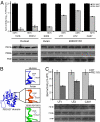Adaptive strategies of the influenza virus polymerase for replication in humans
- PMID: 19995968
- PMCID: PMC2789757
- DOI: 10.1073/pnas.0911915106
Adaptive strategies of the influenza virus polymerase for replication in humans
Abstract
Transmission of influenza viruses into the human population requires surmounting barriers to cross-species infection. Changes in the influenza polymerase overcome one such barrier. Viruses isolated from birds generally contain polymerases with the avian-signature glutamic acid at amino acid 627 in the PB2 subunit. These polymerases display restricted activity in human cells. An adaptive change in this residue from glutamic acid to the human-signature lysine confers high levels of polymerase activity in human cells. This mutation permits escape from a species-specific restriction factor that targets polymerases from avian viruses. A 2009 swine-origin H1N1 influenza A virus recently established a pandemic infection in humans, even though the virus encodes a PB2 with the restrictive glutamic acid at amino acid 627. We show here that the 2009 H1N1 virus has acquired second-site suppressor mutations in its PB2 polymerase subunit that convey enhanced polymerase activity in human cells. Introduction of this polymorphism into the PB2 subunit of a primary avian isolate also increased polymerase activity and viral replication in human and porcine cells. An alternate adaptive strategy has also been identified, whereby introduction of a human PA subunit into an avian polymerase overcomes restriction in human cells. These data reveal a strategy used by the 2009 H1N1 influenza A virus and identify other pathways by which avian and swine-origin viruses may evolve to enhance replication, and potentially pathogenesis, in humans.
Conflict of interest statement
The authors declare no conflict of interest.
Figures




Similar articles
-
Inhibition of Avian Influenza A Virus Replication in Human Cells by Host Restriction Factor TUFM Is Correlated with Autophagy.mBio. 2017 Jun 13;8(3):e00481-17. doi: 10.1128/mBio.00481-17. mBio. 2017. PMID: 28611246 Free PMC article.
-
PB2-588I enhances 2009 H1N1 pandemic influenza virus virulence by increasing viral replication and exacerbating PB2 inhibition of beta interferon expression.J Virol. 2014 Feb;88(4):2260-7. doi: 10.1128/JVI.03024-13. Epub 2013 Dec 11. J Virol. 2014. PMID: 24335306 Free PMC article.
-
Mutations to PB2 and NP proteins of an avian influenza virus combine to confer efficient growth in primary human respiratory cells.J Virol. 2014 Nov;88(22):13436-46. doi: 10.1128/JVI.01093-14. Epub 2014 Sep 10. J Virol. 2014. PMID: 25210184 Free PMC article.
-
Adaptation of avian influenza A virus polymerase in mammals to overcome the host species barrier.J Virol. 2013 Jul;87(13):7200-9. doi: 10.1128/JVI.00980-13. Epub 2013 Apr 24. J Virol. 2013. PMID: 23616660 Free PMC article. Review.
-
Influenza A Virus-Host Specificity: An Ongoing Cross-Talk Between Viral and Host Factors.Front Microbiol. 2021 Nov 5;12:777885. doi: 10.3389/fmicb.2021.777885. eCollection 2021. Front Microbiol. 2021. PMID: 34803997 Free PMC article. Review.
Cited by
-
Reduction of Neuraminidase Activity Exacerbates Disease in 2009 Pandemic Influenza Virus-Infected Mice.J Virol. 2016 Oct 14;90(21):9931-9941. doi: 10.1128/JVI.01188-16. Print 2016 Nov 1. J Virol. 2016. PMID: 27558428 Free PMC article.
-
Prevailing PA Mutation K356R in Avian Influenza H9N2 Virus Increases Mammalian Replication and Pathogenicity.J Virol. 2016 Aug 26;90(18):8105-14. doi: 10.1128/JVI.00883-16. Print 2016 Sep 15. J Virol. 2016. PMID: 27384648 Free PMC article.
-
PA from an H5N1 highly pathogenic avian influenza virus activates viral transcription and replication and induces apoptosis and interferon expression at an early stage of infection.Virol J. 2012 Jun 8;9:106. doi: 10.1186/1743-422X-9-106. Virol J. 2012. PMID: 22681768 Free PMC article.
-
Emerged HA and NA mutants of the pandemic influenza H1N1 viruses with increasing epidemiological significance in Taipei and Kaohsiung, Taiwan, 2009-10.PLoS One. 2012;7(2):e31162. doi: 10.1371/journal.pone.0031162. Epub 2012 Feb 6. PLoS One. 2012. PMID: 22328930 Free PMC article.
-
Virulence determinants of pandemic influenza viruses.J Clin Invest. 2011 Jan;121(1):6-13. doi: 10.1172/JCI44947. Epub 2011 Jan 4. J Clin Invest. 2011. PMID: 21206092 Free PMC article. Review.
References
-
- Novel Swine-Origin Influenza A (H1N1) Investigation Team. Emergence of a novel swine-origin influenza A (H1N1) virus in humans. N Engl J Med. 2009;360:2605–2615. - PubMed

